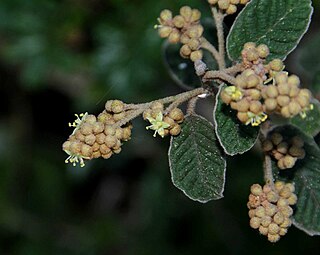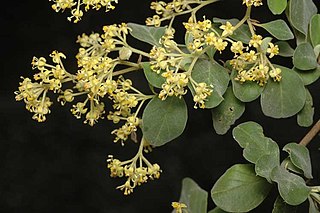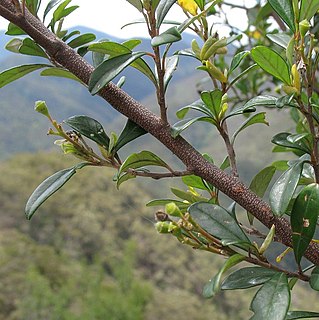
Pomaderris oraria, commonly known as Bassian dogwood, is a species of flowering plant in the family Rhamnaceae and is endemic to south-eastern Australia. It is a compact shrub with hairy branchlets, hairy, elliptic leaves and panicles of hairy, greenish to cream-coloured or crimson-tinged flowers.

Pomaderris paniculosa, commonly known as scurfy pomaderris, is a species of flowering plant in the family Rhamnaceae and is native to Australia and New Zealand. It is a shrub with hairy branchlets, round to elliptic or egg-shaped leaves with the narrower end towards the base and panicles of hairy, cream-coloured to greenish, sometimes crimson-tinged flowers.

Pomaderris bodalla, commonly known as Bodalla pomaderris, is a species of flowering plant in the family Rhamnaceae and is endemic to New South Wales. It is a shrub with hairy young stems, elliptic to more or less rhombic leaves, and dense clusters of cream-coloured flowers.
Pomaderris briagolensis is a species of flowering plant in the family Rhamnaceae and is endemic to Victoria, Australia. It is a shrub with hairy branchlets, egg-shaped or oblong leaves and panicles of white to rust-coloured flowers.

Pomaderris brogoensis is a species of flowering plant in the family Rhamnaceae and is endemic to south-eastern New South Wales. It is a slender shrub or spreading tree with hairy branchlets, egg-shaped to more or less round leaves, and clusters of yellowish flowers.
Pomaderris coomingalensis is a species of flowering plant in the family Rhamnaceae and is endemic to Queensland. It is a shrub with hairy young stems, egg-shaped or elliptic leaves, and clusters of cream-coloured or yellow flowers.
Pomaderris crassifolia is a species of flowering plant in the family Rhamnaceae and is endemic to eastern Australia. It is a shrub with hairy young stems, egg-shaped or elliptic leaves, and clusters of cream-coloured or yellow flowers.

Pomaderris elachophylla, commonly known as lacy pomaderris, small leaf pomaderris or small-leaf dogwood, is a species of flowering plant in the family Rhamnaceae and is endemic to south-eastern Australia. It is a slender shrub with densely hairy branchlets, egg-shaped leaves, and cream-coloured flowers arranged singly or in clusters in leaf axils.
Pomaderris flabellaris, commonly known as fan pomaderris, is a species of flowering plant in the family Rhamnaceae and is endemic to South Australia. It is a low shrub with fan-shaped leaves, and small clusters of woolly-hairy flowers.

Pomaderris gilmourii is a species of flowering plant in the family Rhamnaceae and is endemic to Deua National Park in New South Wales. It is a shrub with hairy young stems, egg-shaped to elliptic leaves, and clusters of silvery buds and creamy-yellow flowers.
Pomaderris graniticola is a species of flowering plant in the family Rhamnaceae and is endemic to eastern Australia. It is a shrub or small tree with hairy young stems, lance-shaped to elliptic leaves, and sparse panicles of yellow, white or cream-coloured flowers.

Pomaderris ligustrina, commonly known as privet pomaderris, is a species of flowering plant in the family Rhamnaceae and is endemic to south-eastern continental Australia. It is a shrub with hairy stems, lance-shaped to narrowly elliptic leaves, and loose clusters of cream-coloured or yellow flowers.

Pomaderris myrtilloides is a species of flowering plant in the family Rhamnaceae and is endemic to near-coastal areas of southern Western Australia. It is an erect shrub with many branches, narrowly egg-shaped elliptic or wedge-shaped leaves with the narrower end towards the base, and cream-coloured to pale pink flowers.

Pomaderris obcordata, commonly known as wedge-leaved pomaderris, is a species of flowering plant in the family Rhamnaceae and is endemic to South Australia. It is a shrub with densely hairy branchlets, wedge-shaped, narrowly egg-shaped or heart-shaped leaves with the narrower end towards the base, and white to pink flowers.
Pomaderris oblongifolia is a species of flowering plant in the family Rhamnaceae and is endemic to eastern Victoria. It is a slender shrub with densely hairy young stems, oblong to narrowly egg-shaped leaves and panicles of hairy, greenish to deep maroon flowers.

Pomaderris phylicifolia, commonly known as narrow-leaf pomaderris, is a species of flowering plant in the family Rhamnaceae and is to south-eastern Australia and New Zealand. It is a slender shrub with hairy stems, narrowly egg-shaped to linear leaves, and small clusters of cream-coloured to yellow flowers.
Pomaderris precaria is a species of flowering plant in the family Rhamnaceae and is endemic to New South Wales. It is a slender shrub with hairy new growth, elliptic to lance-shaped leaves with the narrower end towards the base, and panicles of cream-coloured flowers.
Pomaderris subplicata, commonly known as concave pomaderris, is a species of flowering plant in the family Rhamnaceae and is endemic to Victoria in Australia. It is a shrub with softly-hairy branchlets, egg-shaped leaves, sometimes with the narrower end towards the base, and small clusters of pale yellow flowers.
Pomaderris virgata, commonly known as upright pomaderris, is a species of flowering plant in the family Rhamnaceae and is endemic to south-eastern continental Australia. It is an erect, slender shrub with hairy branchlets, lance-shaped, narrowly elliptic or oblong leaves, and dense panicles of golden-yellow flowers.
Pomaderris viridis is a species of flowering plant in the family Rhamnaceae and is endemic to south-eastern continental Australia. It is a shrub or small tree with hairy young stems, egg-shaped to elliptic leaves, and panicles of cream-coloured to pale yellowish-green flowers.










